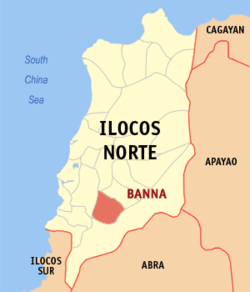Banna, Ilocos Norte
Banna, officially the Municipality of Banna (Ilocano: Ili ti Banna; Filipino: Bayan ng Banna), is a 4th class municipality in the province of Ilocos Norte, Philippines. According to the 2015 census, it has a population of 19,438 people.[3]
Banna | |
|---|---|
| Municipality of Banna | |
 Map of Ilocos Norte with Banna highlighted | |
OpenStreetMap 
| |
.svg.png) Banna Location within the Philippines | |
| Coordinates: 17°59′N 120°39′E | |
| Country | |
| Region | Ilocos Region (Region I) |
| Province | Ilocos Norte |
| District | 2nd District |
| Founded | 1913 |
| Barangays | 20 (see Barangays) |
| Government | |
| • Type | Sangguniang Bayan |
| • Mayor | Carlito A. Abadilla II |
| • Vice Mayor | Mary Chrislyn C. Abadilla |
| • Congressman | Eugenio Angelo M. Barba |
| • Electorate | 12,951 voters (2019) |
| Area | |
| • Total | 92.73 km2 (35.80 sq mi) |
| Population (2015 census)[3] | |
| • Total | 19,438 |
| • Density | 210/km2 (540/sq mi) |
| • Households | 4,421 |
| Economy | |
| • Income class | 4th municipal income class |
| • Poverty incidence | 12.79% (2015)[4] |
| • Revenue (₱) | 122,967,317.57 (2016) |
| Time zone | UTC+8 (PST) |
| ZIP code | 2908 |
| PSGC | |
| IDD : area code | +63 (0)77 |
| Climate type | tropical monsoon climate |
| Native languages | Ilocano Tagalog |
| Website | www |
The word Banna was taken from the native chieftain named Bana. It was formerly known as Espiritu. The name changed under Sangguniang Panlalawigan (SP) Resolution No. 120-95 on March 20, 1995; ratified on March 10, 1996.
Barangays
Climate
| Climate data for Banna, Ilocos Norte | |||||||||||||
|---|---|---|---|---|---|---|---|---|---|---|---|---|---|
| Month | Jan | Feb | Mar | Apr | May | Jun | Jul | Aug | Sep | Oct | Nov | Dec | Year |
| Average high °C (°F) | 27 (81) |
28 (82) |
30 (86) |
32 (90) |
31 (88) |
31 (88) |
30 (86) |
30 (86) |
30 (86) |
29 (84) |
28 (82) |
27 (81) |
29 (85) |
| Average low °C (°F) | 19 (66) |
20 (68) |
21 (70) |
23 (73) |
24 (75) |
25 (77) |
25 (77) |
25 (77) |
24 (75) |
23 (73) |
22 (72) |
21 (70) |
23 (73) |
| Average precipitation mm (inches) | 38 (1.5) |
37 (1.5) |
37 (1.5) |
49 (1.9) |
181 (7.1) |
214 (8.4) |
264 (10.4) |
251 (9.9) |
243 (9.6) |
229 (9.0) |
129 (5.1) |
96 (3.8) |
1,768 (69.7) |
| Average rainy days | 11.6 | 10.7 | 12.4 | 15.2 | 22.6 | 25.0 | 26.1 | 24.9 | 24.3 | 19.2 | 16.4 | 15.4 | 223.8 |
| Source: Meteoblue [5] | |||||||||||||
Demographics
| Year | Pop. | ±% p.a. |
|---|---|---|
| 1903 | 4,015 | — |
| 1918 | 6,639 | +3.41% |
| 1939 | 7,608 | +0.65% |
| 1948 | 8,611 | +1.39% |
| 1960 | 9,972 | +1.23% |
| 1970 | 11,671 | +1.58% |
| 1975 | 12,434 | +1.28% |
| 1980 | 12,887 | +0.72% |
| 1990 | 15,342 | +1.76% |
| 1995 | 15,975 | +0.76% |
| 2000 | 16,704 | +0.96% |
| 2007 | 18,161 | +1.16% |
| 2015 | 19,438 | +0.85% |
| Source: Philippine Statistics Authority[3][6][7][8] | ||
In the 2015 census, the population of Banna, Ilocos Norte, was 19,438 people,[3] with a density of 210 inhabitants per square kilometre or 540 inhabitants per square mile.
Notable people
- Linabelle Villarica, Filipino politician, City Mayor of Meycauayan, Bulacan, wife of Henry Villarica
gollark: It's not a moderator thing. You can just click the "ping off" switch.
gollark: I will write a more coherent response when at an actual keyboard.
gollark: I am everywhere.
gollark: Perhaps you're just bad at comparing.
gollark: Cool people like me can compare anything to anything else.
References
- "Municipality". Quezon City, Philippines: Department of the Interior and Local Government. Retrieved 31 May 2013.
- "Province: Ilocos Norte". PSGC Interactive. Quezon City, Philippines: Philippine Statistics Authority. Retrieved 12 November 2016.
- Census of Population (2015). "Region I (Ilocos Region)". Total Population by Province, City, Municipality and Barangay. PSA. Retrieved 20 June 2016.
- "PSA releases the 2015 Municipal and City Level Poverty Estimates". Quezon City, Philippines. Retrieved 1 January 2020.
- "Banna: Average Temperatures and Rainfall". Meteoblue. Retrieved 4 March 2020.
- Census of Population and Housing (2010). "Region I (Ilocos Region)". Total Population by Province, City, Municipality and Barangay. NSO. Retrieved 29 June 2016.
- Censuses of Population (1903–2007). "Region I (Ilocos Region)". Table 1. Population Enumerated in Various Censuses by Province/Highly Urbanized City: 1903 to 2007. NSO.
- "Province of Ilocos Norte". Municipality Population Data. Local Water Utilities Administration Research Division. Retrieved 17 December 2016.
External links
- Banna Profile at PhilAtlas.com
- Philippine Standard Geographic Code
- Philippine Census Information
- Local Governance Performance Management System
This article is issued from Wikipedia. The text is licensed under Creative Commons - Attribution - Sharealike. Additional terms may apply for the media files.